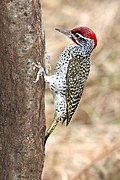| Campethera | |
|---|---|
 | |
| A male golden-tailed woodpecker (C. abingoni) in northern Namibia | |
| Scientific classification | |
| Kingdom: | Animalia |
| Phylum: | Chordata |
| Class: | Aves |
| Order: | Piciformes |
| Family: | Picidae |
| Tribe: | Picini |
| Genus: | Campethera G.R. Gray, 1841 |
| Type species | |
| Dendromus brachyrhynchus [1] Gray, 1841 | |
| Species | |
see text | |
Campethera is a genus of bird in the family Picidae, or woodpeckers, that are native to sub-Saharan Africa. Most species are native to woodland and savanna rather than deep forest, and multiple species exhibit either arboreal or terrestrial foraging strategies. [2] Its nearest relative is the monotypic genus Geocolaptes [2] of southern Africa, which employs terrestrial foraging and breeding strategies. They are however not close relatives of similar-looking woodpeckers in the "Dendropicos clade".


















